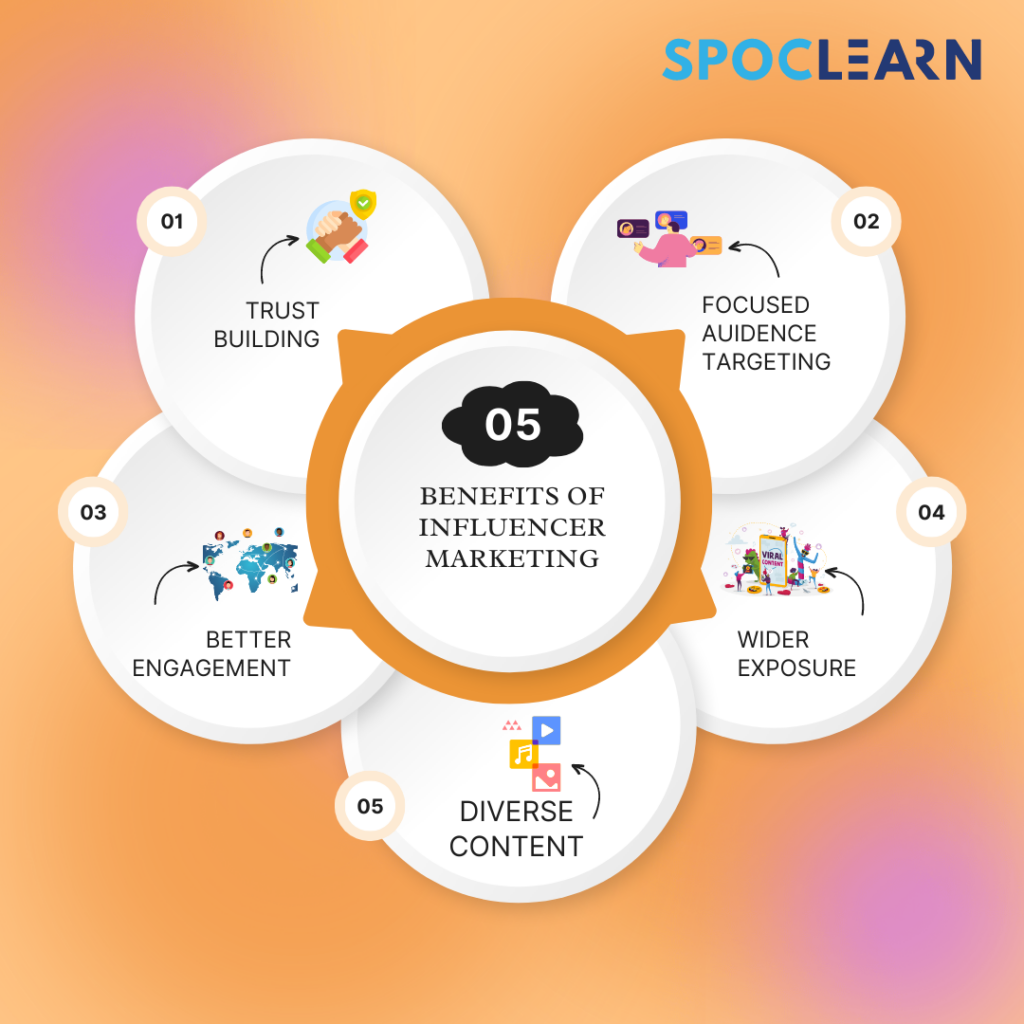Table of Contents
ToggleBeing the hotcake in the world of digital marketing, influencer marketing is the rising star that marketers are highlighting as one of their crucial marketing strategies. It is a significant way to reach and engage your target audience. Working with influencers who have a large following and credibility in certain niches, and celebrity endorsements creates a monumental impact. An Influencer Marketing Hub survey revealed that 61% of consumers have faith in influencers, compared to 38% of consumers who have faith in brand-created content.
Whether you are a marketing enthusiast who wants to learn more about influencer marketing through the best digital marketing courses or you are looking for guidance from the best digital marketing training institute, you need to learn more about your brands and products. In this article, we are going to dive into influencer marketing, explore its potential, and give you some tips and strategies to get the most out of this powerful marketing approach.
Comprehensive Checklist
Before you start implementing strategies and ideas on influencer marketing, you should be aware of the following points:
- Set creative goals- Before you get started on your influencer marketing, it’s a good idea to have some goals in mind. Whether you want to get more people to know about your brand, increase sales, or get more people to follow you on social media, having clear objectives will help you reach them and make sure your campaign is running smoothly. Depending on your brand you have to choose if you need B2B influencer marketing or anything else.
- Influencer research– Partnering with the wrong influencer can lead to dissatisfied results and impact your brand’s reputation. Choosing the right influencer for your influencer marketing campaign is an important step for success.
- Audience– While it’s important to consider the influencer’s following size, it’s also important to consider the engagement rate. For example, a smaller influencer who has a high engagement rate may be a better option than a bigger influencer with a lower engagement rate.
- Authenticity– When working with an influencer, it is important to ensure that they are genuine and open with their audience. It is best to avoid collaborating with influencers with a history of fraudulent followers or a reputation for authenticity.
- Niche– Ensure that the influencer you select has a presence in your niche. For instance, if you’re in the clothing industry, you’ll want to collaborate with an influencer with a large audience of fashion enthusiasts.
- Brand alignment– Find an influencer with a personal brand that resonates with your brand’s values and message. That way, the content they produce for your campaign will be authentic and resonate with your audience.
- Engagement rate– The engagement rate is the proportion of followers that interact with an influencer’s posts. An influencer with a high engagement rate is likely to have a loyal and active following.
- Budget Allocation- Determine your budget for influencer collaborations. This includes influencer fees, content creation costs, and any additional expenses like product samples or event invitations.
- Contract and Agreements- Create a comprehensive contract that outlines deliverables, compensation, content usage rights, and any other terms of the partnership. Legal clarity is crucial to avoid misunderstandings.
- Measurable Metrics- Decide on key performance indicators (KPIs) to measure the success of your campaign. Metrics could include engagement rates, click-through rates, website traffic, and sales conversions.
- Building Relationships- Once you have identified the influencers you are interested in, you can begin to cultivate a relationship with them. Monitor their activity on social media platforms, interact with their content, and contact them via email to explore potential partnerships. To maximize the effectiveness of your email outreach, a link to the influencer’s most recent post or video should be included.
Advantages of Influencer Marketing
Influencer marketing brings a bouquet of benefits to your marketing strategy, infusing it with authenticity, reach, and engagement. Let’s explore these advantages in a professional yet approachable manner-

Genuine Trust-building: Collaborating with different types of influencers fosters trust. Their audience values their authentic opinions, akin to seeking advice from a trusted friend. This trust rubs off on your brand, instantly boosting credibility.
How does it help your marketing strategy?
By aligning with influencers whose values align with your brand, you weave an honest narrative. This, in turn, resonates more profoundly with your target audience, building lasting relationships.
Laser-focused Audience Targeting: Influencers are magnets for specific demographics. Partnering with the right influencer means your message lands exactly where it should, hitting the bullseye of your target audience.
How does it help your marketing strategy?
Your marketing efforts become a sniper’s shot, not a scattergun approach. With influencers, you fine-tune your aim, making your message both effective and efficient.
Engagement Elevation: Influencers have a knack for crafting captivating content. This charisma encourages active participation – likes, comments, and shares galore – making your brand a part of lively conversations. Every business has a specific niche or a USP based on which it wants to create a statement in the industry. One can also pull off a branding strategy like a pro using micro-influencers. They may not have a large audience support but if your brand resonates with that audience, don’t think twice!
How does it help your marketing strategy?
With influencers at the helm, your brand’s engagement skyrockets. You nurture a community around your products, driving sustained interest and enthusiasm.
Wider Brand Exposure: Influencers come with a pre-packaged gift: a ready-made audience. This means your brand enjoys exposure to a broader spectrum of potential customers without the usual struggle. They hype your brand on multiple social media channels like short form of videos (TikTok, Instagram reels, YouTube shorts, etc.) that when linked with your website effortlessly skyrocket website health and rank on the search engine.
How does it help your marketing strategy?
Through influencers, you set sail on uncharted waters, reaching new horizons of visibility. This, in turn, translates to heightened brand recognition and recall.
Diverse Content Deluge: Influencers are maestros of content creation. Their knack for innovation means your brand’s narrative is presented in various engaging formats, catering to all tastes. Recommending your brand or service on major social networking sites and popular social media platforms automatically will generate noteworthy traffic.
How does it help your Marketing strategy?
You inject diversity into your content ecosystem. Fresh, dynamic content equates to higher audience engagement and prolonged attention spans.
How can a business assess the ROI from influencer marketing?
Assessing ROI from influencer marketing is not only possible but can be quite rewarding. For instance, The fashion industry is generating a mammoth revenue and its ROI is skyscraping like never before ever since it started collaborating with fashion influencers. A survey profoundly announces that the global fashion influencer marketing market size was valued at USD 1.5 billion in 2019. It is expected to expand at a compound annual growth rate (CAGR) of 35.7% from 2020 to 2027.
The points below will spill the tea-
- Setting Solid Goals – First things first, set clear and specific goals. Whether it’s increased sales, brand awareness, or website traffic, having defined objectives lets you measure success accurately. Think of it as setting sail with a treasure map. The “X” marks your goals, and every step brings you closer to uncovering the treasure trove of ROI.
- Unique Tracking Links – Equip influencers with unique tracking links or promo codes. This tech-savvy approach lets you trace every click, conversion, and sale directly back to the influencer’s efforts. It’s like leaving breadcrumbs in the digital forest. You can easily follow the trail to see which path leads to the ROI castle.
- Engagement Metrics – Dive into engagement metrics – likes, shares, comments. Higher engagement often translates to increased interest and, eventually, a more delightful ROI. Engagement metrics are like the applause after a riveting performance. More claps, more engagement, more value!
- Website Traffic Analytics – Monitor your website traffic during and after the influencer campaign. Notice a spike? That’s the influencer magic at work, directing visitors to your online kingdom. It’s like having a VIP entry lane at an amusement park. If there’s a rush, you know who to thank for the excitement!
- Social Media Insights – Keep a watchful eye on social media insights. Increased follower count, mentions, and profile visits are indicators of the influencer’s impact on your brand. Social media insights are like a sneak peek into the backstage of your influencer-powered show. The more behind-the-scenes action, the bigger the ROI spotlight!
- Conversion Rate Calculations – Calculate conversion rates by comparing the number of conversions (sales, sign-ups) to the total number of people who interacted with the influencer’s content. It’s like turning spectators into performers. The more people waltzing into your conversion stage, the grander the ROI performance.
- Monetary Return vs. Investment – Compare the monetary returns generated from the influencer campaign to the initial investment, including influencer fees, content creation costs, and other expenses. It’s like a classic “more in, more out” scenario. When your ROI dwarfs the investment, you’re dancing your way to success!
- Long-term Value – Consider the potential long-term value of influencer partnerships. A positive and ongoing relationship can lead to sustained benefits, amplifying your ROI over time. It’s just like planting trees. As it grows, the shade it provides (your ROI) expands, making your brand landscape even more delightful.
- Potential Risks – Onboarding the wrong influencer for your marketing campaign can lead to several significant risks. Here are five major potential risks:
- Brand Misalignment – Partnering with an influencer whose values, content, or audience don’t align with your brand can result in a misrepresentation of your products or services. This misalignment can confuse your target audience and damage your brand’s reputation.
- Credibility Loss – If the influencer has a history of promoting products that are inconsistent with your brand’s quality or values, their endorsement might not be taken seriously. This can lead to a loss of credibility for both the influencer and your brand.
- Negative Publicity – If the influencer becomes involved in controversies or receives negative publicity, their association with your brand could lead to unintended negative perceptions. This negative association might harm your brand’s image and hinder your campaign’s success.
- Engagement Issues – An influencer with fake followers or low engagement rates might not deliver the level of interaction you expect. Your campaign could fall flat, failing to engage your target audience effectively.
- Wasted Resources – Collaborating with the wrong influencer means your resources – time, money, and effort – could be invested in a partnership that doesn’t yield the desired results. This waste of resources could have been better utilized in a more strategic collaboration.
Conclusion
The world of influencer marketing offers an array of opportunities and challenges for businesses seeking to enhance their brand presence. By strategically partnering with the right influencers, businesses can amplify their brand message, engage with their audience on a deeper level, and achieve faster results, all while fostering an authentic and credible image.
In the ever-evolving realm of digital marketing, influencer collaborations stand as both a powerful tool and a strategic challenge. By understanding both the advantages and risks, businesses can navigate this landscape with confidence, forging meaningful connections, and propelling their brand towards lasting success.
